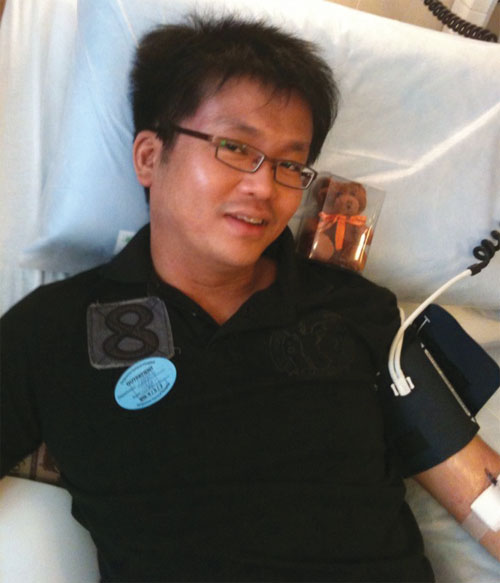 Jared Lim signed up to be a bone marrow donor five years ago and received a call last year informing him of a match. He tells City News his story.
Jared Lim signed up to be a bone marrow donor five years ago and received a call last year informing him of a match. He tells City News his story.
Jared Lim, a credit analyst, was initially unsure about signing up as a bone marrow donor in 2005. He had gone to a blood donation drive organized by City Harvest Community Services Association, with the intention to donate blood. While there, a bone marrow donor program that was being held concurrently drew his interest.
In spite of the uncertainty he faced about the entire procedure and what it entailed, he went ahead and signed up as a donor. Five years later, Lim received a call informing him that his bone marrow was found to be a match for a young lady who was dying.
“I was surprised to be the only match in the registry, especially since the patient and I are unrelated. The probability [for an unrelated match] is a 1-in-20,000 chance,” says Lim, 30.
The Bone Marrow Donor Programme website (www.bmdp.org) reports that every year, thousands of children and adults with fatal bone marrow diseases, like leukemia, lymphoma and other blood related disorders reach a stage when their only hope of survival is a blood stem cell transplant from a bone marrow donor who shares the same “tissue type.”
In a family, siblings have a one-in-four chance of being a match. However, with small families, this is not always an option. Patients are often reliant on an unrelated donor to offer them a second chance at life.
Lim personally witnessed a friend battle with leukemia before passing away at the tender age of 20. “I recalled visiting him and seeing him go through numerous rounds of chemotherapy.
“My friend could have been here today, with his whole life ahead of him, if there had been a donor who was a match. This thought spurred me on.”
So when Lim was informed of the match, he promptly went for a series of three tests. The first round required three vials of blood to be drawn for a high resolution test. This was followed by the second round, requiring 12 vials of blood after Lim was identified as a very suitable donor. After a series of X-rays, ECGs and physical examinations, and another drawing of four vials of blood, Lim was ready.
He opted for the less invasive procedure, a method known as the PBSC (peripheral blood stem cell) harvest. This
involves several injections to encourage blood stem cells to move into the circulating blood stream. The stem cells are then collected as an outpatient procedure and drawn from the blood via a blood separator machine.
The entire procedure lasted over five days. Lim had to travel down to the Singapore General Hospital every morning for three days to receive injections to boost his stem cell production. The stem cell harvest procedure began on the fourth day at the Haemotogy Centre—both of Lim’s arms were hooked to a machine from 10:30 a.m. to 4:30 p.m. The fifth and final day involved only one arm.
The entire procedure may sound complex and frightening, but Lim assures that it is not so.
He says, “The pain throughout the whole process is minimal. The only side effects were prior to the procedure due to the injection of G-CSF for four consecutive days. I developed flu-like symptoms and backaches but all these can be treated with painkillers.”
He adds, “The pain suffered by the patients is much worse.”
Lim says it took him only two days to recover from the entire procedure. Apart from feeling tired and weak, Lim says he was fine. He was also told not to lift heavy loads for a few days.
 |
| PHOTO COURTESY OF JARED LIM |
His wife and boss both echoed their support for him. His wife, Jer Blinn, encouraged him to go for it, while his boss gave him a few days off for the procedure and subsequent rest, saying, “It’s great to be able to help save someone’s life.”
When asked if he would go through the procedure all over again, Lim answers without hesitation, “Yes, of course!
“By signing up as a bone marrow donor, you are the potential lifeline for someone out there! Don’t deny someone’s desire to live. He or she has dreams and aspirations to fulfill in life, just like you and I,” he says.
To date, the Bone Marrow Donor Programme has 44,000 donors in the register and they are constantly looking for more. For additional queries, please visit www.bmdp.org.
The Bone Marrow Donor Programme
To locate an unrelated volunteer donor, the odds are one in 20,000—that person must first be on a register such as the BMDP. The BMDP is a nonprofit group set up in Singapore since 1993, with the aim of building a register of Singaporeans who are willing to donate bone marrow to those with blood diseases such as leukemia.
To significantly improve the chances of finding compatible unrelated donors, the BMDP is targeting to recruit 5,000 donors in Singapore each year.
Who may register as a bone marrow donor?
• Individuals in good health
• Between the ages of 17 and 49
• With no past histories of blood disorders or cancers
How do you register as a bone marrow donor?
• You can register with the BMDP at one of their donor drives, or walk-in at the BMDP office from 9 a.m. to 6 p.m. on Tuesdays to Fridays.
• Simply fill in a registration form
• Through a simple finger-prick, they obtain a drop of blood. Blood samples are then sent for tissue-typing and added to the BMDP register of potential donors.
